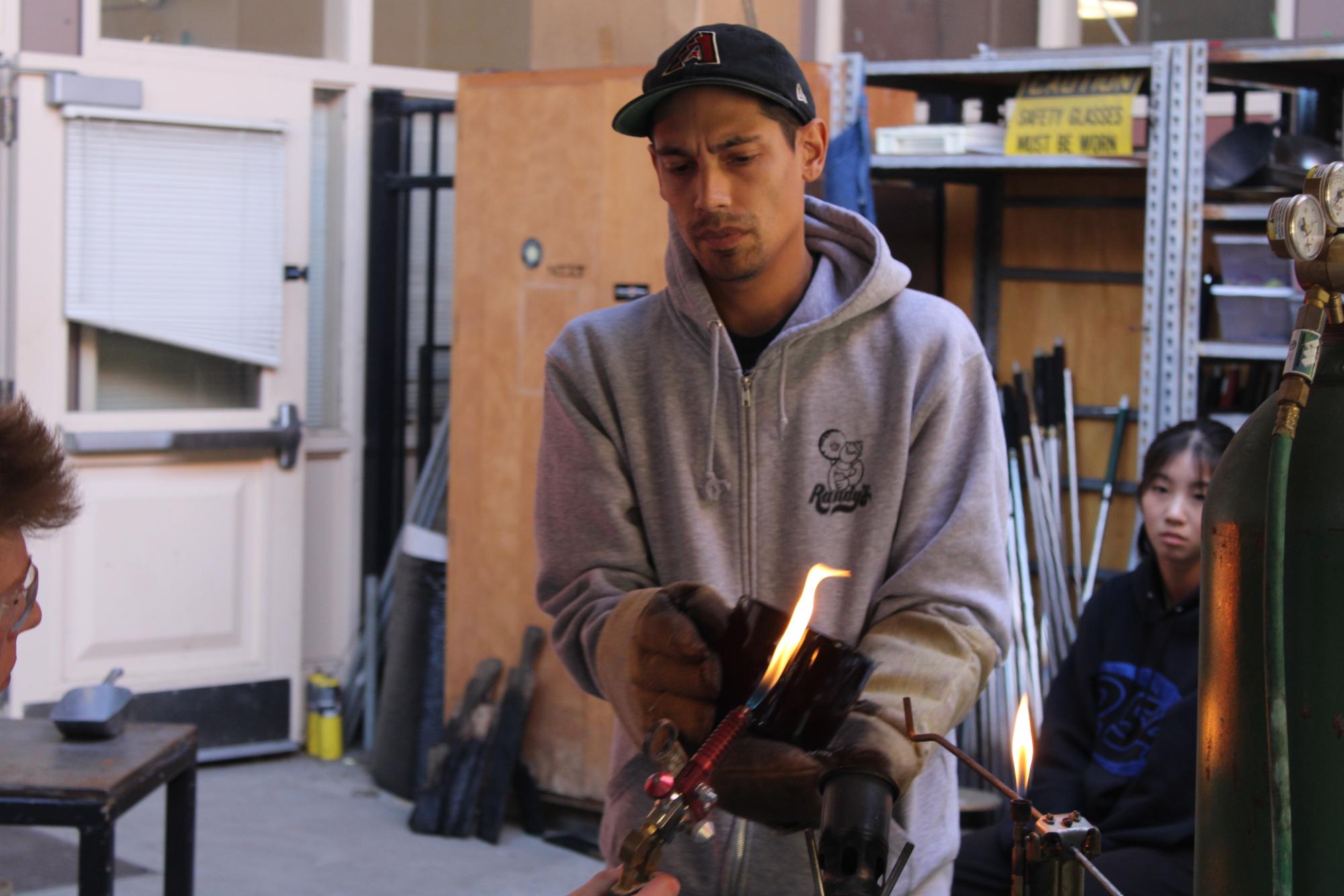
For Palo Alto high school visual arts teacher Michael Da Ponte, teaching wasn’t exactly a pathway he envisioned pursuing.
“I kinda fell … into that [job],” he said.
Da Ponte originally studied design in college, with an internship lined up after graduation with the Blackhawks, a hockey team. But in senior year, he discovered his true passion — glassblowing.
“I derailed my plans and stayed [in college] a couple of years to learn glass,” Da Ponte said.
After graduating, he taught glassblowing at a Chicago high school for 12 years. Over the summer, a new opportunity presented itself — teaching at Paly.
“I got fed up with my old school and the admin there, then this job showed up,” Da Ponte said. “It was a unique chance to take over a program and make it my own.”
One of Da Ponte’s first challenges at Paly has been garnering enough interest in the glassblowing program. As much as Da Ponte enjoys glassblowing, he recognizes that the process may be a hard sell for some students.
“It’s physical and really hot,” Da Ponte said. “You get sweaty and kinda gross — not everyone wants to do that.”
Da Ponte plans to create a more inclusive curriculum — one which not only offers opportunities for students to partake in the glassblowing process without hands-on, lifting-glass-into-kiln action, but also allows kids to implement other forms of art.
“There will be more variety for kids that don’t want to get hot, sweaty, and gross in the shop,” Da Ponte said. “We’ll also layer the knowledge and have more techniques that kids can go off of — if they want to do ceramics, combine both ceramics and glass together, for example.”
In his free time, Da Ponte is an artist himself.
“The current stuff I’ve been making is typography — the use of letters and characters in graphic design,” Da Ponte said. “I make letters into these huge glass figures, and use them to tell a narrative about my identity and who I am as a person.”
His website, mikedaponte.com, showcases some of his work. In one image, a three-dimensional, glass letter C is laid over sideways, a glass baby cradled in its grasp. The title reads “C is for Carry.” In another, a chimney protrudes from the letter A’s right side, amplifying the homey feeling the piece’s emerald green exterior already projected. This one’s called “A is for Abode.”
Da Ponte said he doesn’t believe in favorite artworks. For him, the process is most valuable.
“It’s less about the object I’m making, and more about the intimate relationship I have with it,” Da Ponte said. “Every piece I make, I spend anywhere from a couple weeks to a couple months making it. By the time I’m done, I’m ready to move on.’” I don’t really sit there and think, ‘oh, I like this piece the best.’”
Da Ponte finds solace not from fixating on past works, but from constantly looking forward to his next artistic pursuit.
“I enjoy the process, and I enjoy making these ideas I have into tangible realities,” Da Ponte said. “My favorite piece is probably the next piece I make, because it’s always like, ‘what’s new, what’s coming, what’s exciting,’”
As an artist, Da Ponte recognizes that sometimes, coming up with an idea is the hardest part of the artistic process.
“I think it’s my job to show my students that I struggle just as much as they do with ideas sometimes,” Da Ponte said. “You need to figure out how to move past those hardships and setbacks.”
Creating art is one thing — teaching it is a whole different story. For Da Ponte, one of the greatest difficulties of teaching has been juggling his innate artistic taste with his responsibility as an educator to accommodate the creative visions of students.
“There’s a lot of artists who are good at what they do, but can’t teach,” Da Ponte said. “If you can do both, you’re in this cool middle ground. It’s a weird thing to teach — art’s very personal, and it takes over your life when you’re a professional.”
That’s why Da Ponte thinks the visual arts department’s evidence-based grading system fits his class like a glove.
Story continues below advertisement
“It’s all performance-based,” Da Ponte said. “As an art teacher, you’re tracking your students as they progress through your class. You can see kids that are a little behind — literally see, because it’s visual, not like math.”
The future of Paly’s visual arts department is bright. Sometime this semester, Da Ponte plans to add an eighth period course after school that will allow students to help him create designs for an actual business.
“I work for a candle company that’s based out in Montana — I’ve been making the vessels that they pour their waxes into,” Da Ponte said. “I’ll use that as a resource to teach kids about production glassblowing. This will be about honing my older guys’ skills, the younger guys will be there to assist and help out.That gets them into the idea of how the functionality of a studio operates.”
The next step? Increasing visual art enrollment — starting young. Da Ponte has floated the idea of allowing middle schoolers to contribute to his potential eighth period class. “A lot of kids come into high school knowing that they like art, but they don’t know the path forward,” he said. “These kids can come in and check it out. We need to tap into the younger kids early on, you know, so we can boost our enrollment in the arts.”
